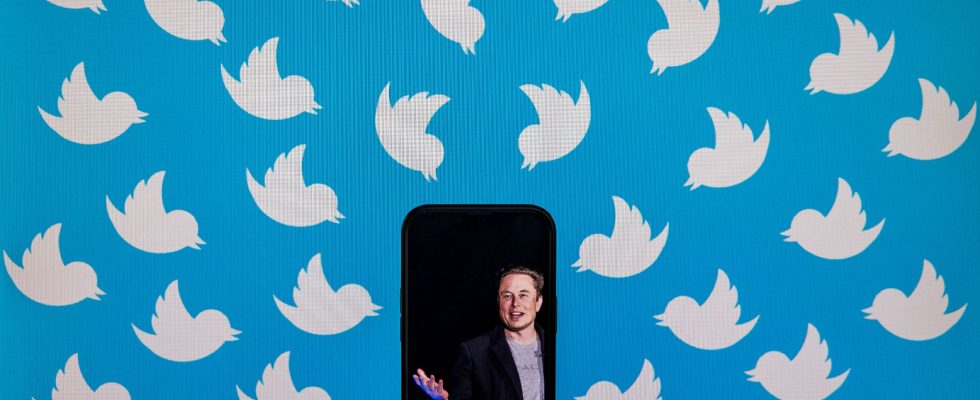On Thursday, April 20, Elon Musk successfully ordered the removal of free certification badges on Twitter. Kylian Mbappé, Elton John, Leonardo DiCaprio and Tony Hawk there are no more than simple fellows (with millions of subscribers, all the same). Almost six months to the day after its forced takeover for 44 billion dollars, the troublemaker of tech has operated, in great confusion, the most important moult of the social network. For the uninitiated, the blue badge, like its totem bird, materialized the authenticity of an account generally belonging to a personality or a company. It gave him greater visibility than the others. The system is rather common on the Web, Meta grants the same badges on Facebook and Instagram.
The acquisition of this badge, in the era of former Twitter bosses, Jack Dorsey, its founder, or his successor Parag Agrawal, was sometimes tedious and sparked debate. Because it was not only a question of the veracity of the information provided, but of social position, notoriety, quality of the remarks made – the most factual and the least hateful possible… In short, elements that were not always obvious to evaluate. This process, entirely human – and by nature imperfect -, however, gave Twitter its raison d’être. That of a social network wanting to be the reflection of a complex world, tilting sometimes to the left, sometimes to the right. With all the shortcomings inherent in certain biases and preferences; in this case, those of employees nestled in the sunny bubble of Silicon Valley. Perhaps aware of these limits, and the weight of the responsibilities, Jack Dorsey himself abandoned his baby a few months after taking the decision to ban the account of Donald Trump, then President of the United States, reducing it de facto in silence.
More than just a notch
The great confusion created by Musk comes not so much from the end of this system as from its replacement: Twitter Blue. This subscription program offers new features ranging from editing tweets to posting long videos. Elon Musk claims to need it in order to straighten out the finances of a network dependent on advertising to survive. Problem: Twitter Blue still carries the same blue notch, accompanied by this famous boost, multiplying by two or even four times the visibility of publications compared to others, according to the recommendation algorithm recently unveiled by Twitter. Who benefits from the crime? To all those who could not obtain this precious blue badge, before Musk took office. Notorious disinformators, like Mike Borowski or “TV Liberté”, now proudly wear theirs.
The mistake would be to see in this phenomenon the simple consequence of a new, more virtuous economic model – since it no longer relies on user data sold to advertisers. Maintaining confusion is part of Musk’s plan. Media as prestigious as the New York Times have thus lost their badge by the simple fact of the prince. Others decided to pack their bags, like Radio-Canada/CBC and NPR, the American public service media (the equivalent of Franceinfo for France), when Elon Musk made the decision to branding them “government funded media” despite their editorial independence. At the same time, all mentions of direct affiliation of accounts with States, and in particular authoritarian regimes, have jumped. Will they be restored? Impossible to know. Recently, press requests addressed to Twitter, which has lost 75% of its employees, have been answered in the form of a “poo” emoji.
All this contributes to the new political coloring of the Twitter news feed. Elon Musk’s page makes it very easy to browse the palette, between his relays of conspiratorial information sites, his remarks relating to an “anti-woke” absolutism, his diatribes against the so-called “mainstream” media of which he banish journalists at will. His conception, finally, of a freedom of expression whose hatred is no longer a limit. Elon Musk has thus won his bet by designing a Twitter diametrically opposed to that imagined by Jack Dorsey seventeen years ago. The great confusion also has its reverses. Advertisers hardly taste it, and they still weigh heavily in Twitter’s trade balance. In addition, the hundreds of millions of Twitter users will be difficult to convert into Blue users, while the major functionalities (those of posting and reading other publications) remain free.
Finally, still on this famous April 20, Jack Dorsey officially launched the first invitations on Android for BlueSky, his new social network, a carbon copy of Twitter, with one detail: the platform will be decentralized this time. A way to follow the evolution of technology, but also of ideas: the centralization of social networks is an insoluble puzzle. Musk may not know that yet. Dorsey knows what he’s talking about.
